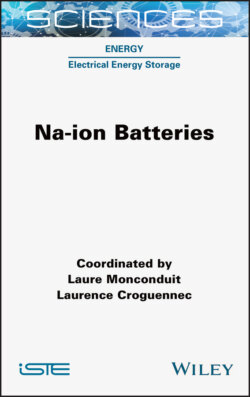Читать книгу Na-ion Batteries - Laure Monconduit - Страница 38
1.4.4. P2-Na2/3[Ni,Mn,M]O2
ОглавлениеSimilar to P2-Nax[Mn, Fe]O2, a solid solution of P2-Na2/3[Ni,Mn]O2 was also studied as a precursor to synthesize a positive electrode material in Li cells by means of Li+/Na+ exchange by Dahn’s group from the late 1990s to the early 2000s (Paulsen and Dahn 2000; Paulsen et al. 2000). Interestingly, the Na battery performance was examined with Na cells and phase transitions were investigated using in situ XRD in 2001 (Lu and Dahn 2001a). P2-Na2/3Ni1/3Mn2/3O2 delivers a reversible capacity of ca. 150 mAh g−1 with stepwise voltage profiles in the range of 2.0–4.5 V, as shown in Figure 1.14. The average working voltage is one of the highest (ca. 3.6 V) among O3- and P2-type materials. However, the reversible capacity rapidly deteriorates during cycles (Lu and Dahn 2001a; Lee et al. 2013). The capacity decay mechanism is explained by phase transition accompanied by significant shrinkage of interslab distance by Na extraction (Yoshida et al. 2014). P2-Na2/3Ni1/3Mn2/3O2 transforms into O2-type Ni1/3Mn2/3O2 by extraction of almost all Na on charge through the two-phase reaction above 4.1 V (Lu and Dahn 2001a) and the P2–O2 phase transition is accompanied by huge volume shrinkage of 23% mainly attributed to shrinkage of the interslab distance (Lee et al. 2013; Yoshida et al. 2014). The volume change significantly influences battery performances such as capacity retention and rate performance in Li and Na batteries and is recently reported to be suppressed by partial metal doping in the Ni1/3Mn2/3O2 slab. For example, our group synthesized P2-Na2/3[Ni1/3Mn1/2Ti1/6]O2 and the Ti-substituted phase delivers a reversible capacity of 127 mAh g−1 with smooth voltage curves as shown in Figure 1.14 (Yoshida et al. 2014). The volume change is successfully suppressed into 12–13% by Ti substitution. Our group systematically compared influence of inert-metal substitution in P2-Na2/3[Ni1/3Mn2/3]O2 and revealed that Al3+ or Ti4+ substitution successfully enhanced the cycling stability and rate performances (Kubota et al. 2018b). Multiple substitution by inert metals such as Cu2+-Ti4+ coupling (Mu et al. 2019) is expected to further improve the electrochemical performances as found for O3-Na[Ni1/2Mn1/2]O2.
Figure 1.14. Comparison of galvanostatic charge/discharge curves of layered P2 type binary and ternary 3d transition metal oxides (left). Morphology of particles for each sample is also compared (right)
